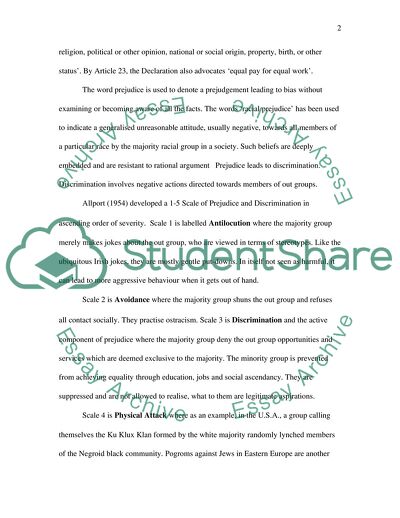
- Home
- Free Samples
- Premium Essays
- Editing Services
- Extra Tools
- Essay Writing Help
- About Us
- Studentshare
- Subjects
- Miscellaneous
- Equality and diversity
Equality and diversity - Essay Example

- Subject: Miscellaneous
- Type: Essay
- Level: Ph.D.
- Pages: 4 (1000 words)
- Downloads: 0
- Author: wolffvernon
Extract of sample "Equality and diversity"
In 1946, 85 nations adopted a Charter for a United Nations followed by, in 1948, a Universal Declaration of Human Rights. The Preamble to the Charter reaffirms ‘faith in fundamental human rights, in the dignity and worth of the human person, in the equal rights of men and women, and of nations large and small’. According to Article 1 (3) of the Charter, one of the main purposes of the United Nations is ‘to achieve international co-operation in promoting and encouraging respect for human rights, and for fundamental freedoms for all without distinction as to race, sex, language or religion’.
This is repeated in Article 55 ( c) of the Charter promoting universal respect for, and observance of human rights and fundamental freedoms for all without distinction as to race, sex, language or religion. The Universal Declaration of Human Rights expands on the above concerns of the UN Charter in Article 2. ‘Everyone is entitled to all the rights and freedoms set forth in the Declaration, without distinction of any kind, such as race, colour, sex, language, religion, political or other opinion, national or social origin, property, birth, or other status’.
By Article 23, the Declaration also advocates ‘equal pay for equal work’. The word prejudice is used to denote a prejudgement leading to bias without examining or becoming aware of all the facts. The words ‘racial prejudice’ has been used to indicate a generalised unreasonable attitude, usually negative, towards all members of a particular race by the majority racial group in a society. Such beliefs are deeply embedded and are resistant to rational argument Prejudice leads to discrimination.
Discrimination involves negative actions directed towards members of out groups. Allport (1954) developed a 1-5 Scale of Prejudice and Discrimination in ascending order of severity. Scale 1 is labelled Antilocution where the majority group merely makes jokes about the out group, who are viewed in
...Download file to see next pages Read MoreCHECK THESE SAMPLES OF Equality and diversity
The Concepts of Equality and Diversity
Equality and Diversity Management
People Management: Equality and Diversity Policies
Equality and Diversity Policy of an Organization
Canada: Equality and Diversity
Managing Equality and Diversity
Equality and Diversity within Health Care
Equality and Diversity in Prisons

- TERMS & CONDITIONS
- PRIVACY POLICY
- COOKIES POLICY